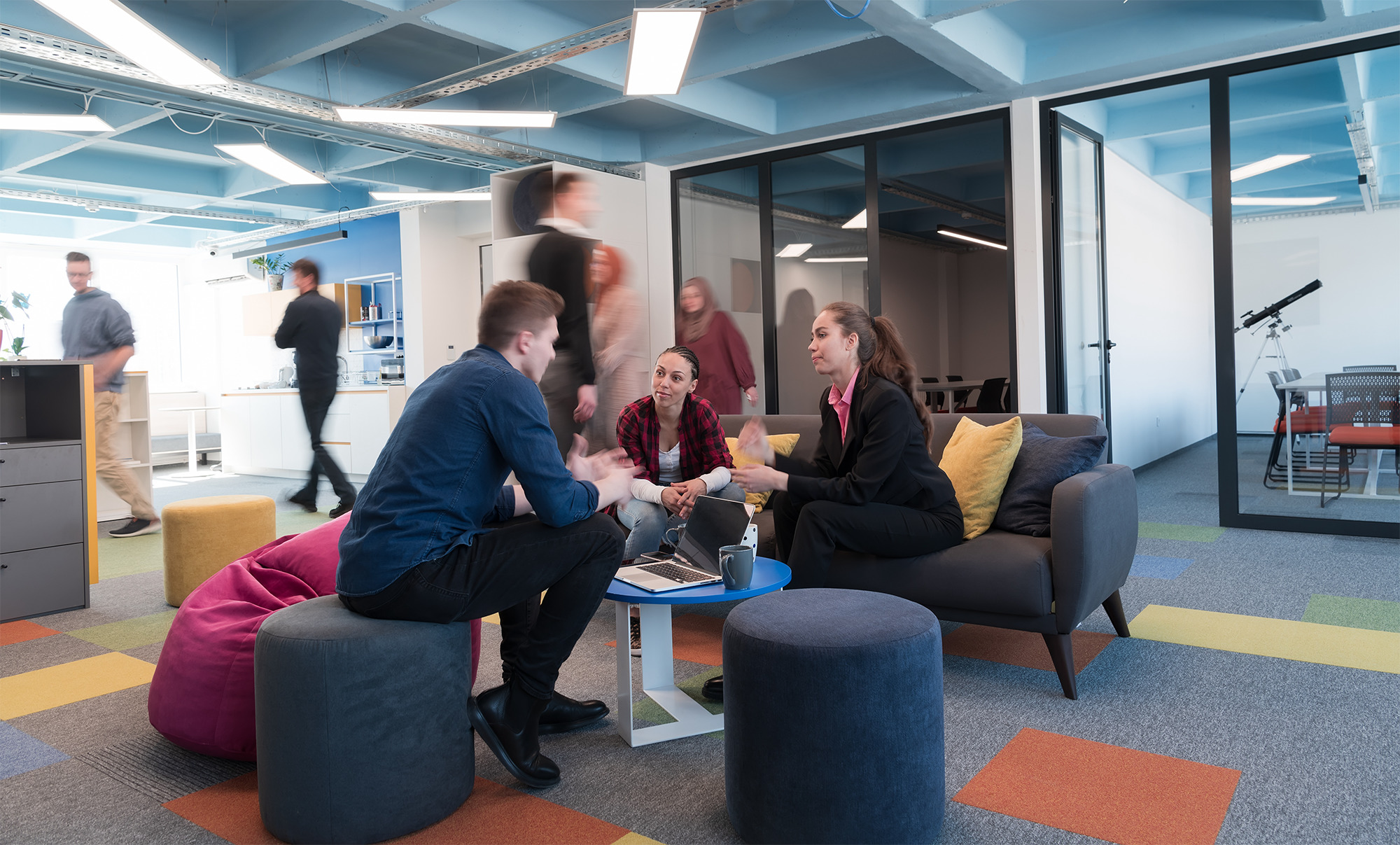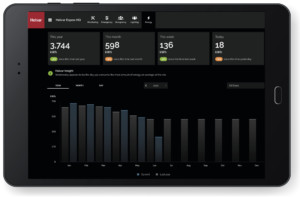Imagine you have been tasked with the lighting design for an office that must follow advanced lighting norms and global standards, as well as incorporating the latest technology available on the market. In this blog, I have summarized the best lighting design practices, referring to well-known and trustworthy international standards such as BREEAM, LEED, and WELL, and incorporating the most advanced technology offered by Helvar.
Before we begin, let’s outline the core statements for our design plan.
Energy efficiency should be considered a key aspect of building sustainability. We should also take into account the impact of our design on the health and wellbeing of building occupants. Finally, we must ensure future investments by offering intelligent and technically future-proof solutions.
Lighting design and sustainability
BREEAM and LEED both focus on a green approach to construction, with the ultimate goal of creating an energy-positive building. In my research, I will refer to BREEAM requirements, but it is fair to say that LEED has similar concepts, so you can choose whichever is best for your project.
BREEAM 2016, Ene 01 Reduction of Energy Use and Carbon Emissions: To recognize and encourage buildings that minimize operational energy demand, internal daylit and non-daylit areas must have switching controls that take into account absence or occupancy. Adequate lighting controls must also be provided for all ancillary areas. These requirements can be easily met by using PIR sensors and a lighting control system. Additionally, it is recommended that at least 80% of general internal luminaires in fixed fittings have an efficacy of at least 65 luminaire lumens/watt or greater. Meeting this efficiency can be challenging, especially when providing high levels of illuminance, but it is achievable with high-quality luminaries.
BREEAM 2016, Ene 02a Energy Monitoring: To recognize and encourage the installation of energy sub-metering for monitoring operational energy consumption, we must install energy metering systems and obtain energy consumption data from all power sources, including lighting. We will need special software that can obtain energy consumption data from different types of loads and send it to the building’s energy monitoring system.
BREEAM 2016, Ene 03 External Lighting: To recognize and encourage the specification of energy-efficient light fittings for external areas, all external light fittings must be automatically controlled to prevent operation during daylight hours and have presence detection in areas of intermittent pedestrian traffic. To control outdoor daylight and detect pedestrian movement, we will need to use an external lighting sensor and PIR sensors.
Lighting design, health and wellbeing
The most advanced research in building design in this field is the WELL Building Standard. We will take the most interesting features from WELL v2 and some points from LEED that would be a good addition.
WELL v2, L02 Light Exposure: To provide visual comfort and enhance visual acuity for all users through electric lighting, one option is to comply with the EN 12464-1 European lighting norms. The new EN lighting norms emphasize that light should be adjusted according to the needs and variability of building occupants and offer adjustability to lighting. The EN 12464-1 provides modified illuminance levels and workspace illumination guidelines, recommending an increase of illuminance in the office from the standard 500 lux to 1000 lux. It is important to note that light should be controllable in most cases, providing illuminance flexibility for users and saving energy when light is not needed.
WELL v2, L03 Circadian Lighting Design: This feature describes requirements for lighting that supports circadian and psychological health through indoor daylight exposure. We will be facing a new metric unit, known as EML (Equivalent Melanopic Lux), which is used for measuring the impact of lighting on health and well-being. The idea is to provide high levels of illuminance to support day-active people and to be able to adjust the light during the evening to match the natural circadian rhythms of humans. A target level would be to have a regularly occupied space with a 275 EML (approximately 800 lux). To implement this feature, we need to have powerful enough lighting fixtures in our space and a lighting control system to adjust the lighting levels and color temperature, if available, for different times of the day according to a schedule.
LEED 4.1 BD+C, EQ Credit: Quality Views: To give building occupants a connection to the natural outdoor environment, we must focus on quality views. It is stated that occupants must have access in the building with a view to the outdoor natural or urban environment for 75% of all regularly occupied floor areas. This feature primarily involves architecture and interior design.
WELL v2, L04 Electric Light Glare Control: To minimize the glare caused by electric light, it is suggested to meet a Unified Glare Rating (UGR) of 16 or lower in all regularly occupied spaces. Glare can be a disaster, and a UGR of 16 may be too strict for an office. However, the WELL standard proves it with the latest studies. In LEED and BREAAM, you will find a UGR of 19 or lower. The UGR level depends on the construction of the lighting fixture and how it is placed in the workspace relative to the workstations.
WELL v2, L05 Daylight Design Strategies: Part 1 of this feature states that 70% of all workstations should be placed within 5 meters of transparent envelope glazing, and the visible light transmittance (VLT) of the glazing must be greater than 40%. The idea behind this feature is to ensure that daylight is accessible enough for all occupants. In Part 2, it is stated that the design must include solar shading, and that shading must be automated to prevent glare. This is easily done with a lighting control system that can use data from external lighting sensors, has sun-tracking software, and can control different types of blind motors.
WELL v2, L07 Visual Balance: It is crucial to create a lighting environment that enhances visual comfort in the office space. To do this, we must consider the horizontal and vertical luminance contrast ratios, an illuminance uniformity ratio of at least 0.4, automatic smooth changes (dimming) in lighting characteristics, such as light levels over a period of 10 minutes, changes in color and distribution, and the correlated color temperature (CCT) in each room for similar fixtures. The CCT should be consistent (+/- 200K) at any point in time. To achieve this, we need to use a lighting control system with a logic module and software that allows detailed adjustments of lighting characteristics for each lighting fixture.
WELL v2, L08 Electric Light Quality: It is important to use high-quality luminaries as their technical parameters have a significant impact on the level of visual comfort and physical perception. The quality of LEDs affects visual comfort due to its color rendering quality. Therefore, the Color Rendering Index (CRI) should be greater than 90 (for example, CRI 100 represents colors as seen in natural daylight). This information can be obtained from the luminaries manufacturer. To prevent headaches, eye strain, and migraines, we must manage the flickering effect, which is the responsibility of LED drivers. To achieve this, the LED drivers must meet the following requirements: Pst LM < 1.0 and SVM < 0.6 for indoor applications. These requirements are usually specified in the LED drivers’ datasheet.
WELL v2, L09 Occupant Lighting Control: Having the ability to control lights and create customizable environments positively impacts our wellbeing and social interactions. Modern offices have several zones for collaboration, communication, and socializing. Controllable lighting levels and color temperature create a positive psychological effect, allowing us to relax or become more energized. The feature recommends at least three lighting levels or scenes per 30m2 of lighting zones, with the ability to adjust light intensity or color temperature (CCT). All regular occupants should have control over their immediate lighting environment through manual controls or digital interfaces available on computers or phones.
Lighting design and future-proof solutions
We have seen that lighting controls are necessary for most of the sustainability features and many of the wellbeing features such as light exposure, circadian lighting design, daylight design strategies, visual balance, and occupant lighting controls. However, to create a truly unique and future-proof design, we need technology that also works with data. The Helvar Insights platform is an example of such technology. Helvar Insights is a scalable cloud-based suite of digital services that leverages data from lighting control devices and sensors to provide intelligent insights that can improve user wellbeing, building efficiency, and sustainability targets. The platform has several modules, including Occupancy Insights, Operating Insights, Monitoring and Control Insights and Wellbeing Insights.
Occupancy Insights provides real-time occupancy heat maps, occupancy trends, and utilization analysis to optimize space and increase efficiency and productivity.
Operating Insights focuses on sustainability and allows for monitoring energy consumption, automatically optimizing PIR timeouts for maximum energy savings, and optimizing the HVAC system based on occupancy predictions.
Monitoring & Control Insights is a powerful tool for on-site operational teams, providing remote control of all lighting via a web interface, real-time alerts, and automatic emergency lighting reports.
Wellbeing Insights (available in 2023) allows for monitoring and presenting environmental conditions with recommendations for improvement. It also integrates environmental data and insights with other systems to enhance wellbeing and efficiency, using a special environmental sensor provided by Helvar.
Having all of these software features is like unlocking the potential of lighting in a building, expanding the functionality of lighting controls and adding intelligence to lighting design by harnessing the power of data.
In conclusion, we understand that good lighting design is complex, and many factors and details must be considered, such as building architecture, interior design, zoning, task type, age of people, social aspects, energy efficiency, luminaries technical parameters, special software, and more. Fortunately, we have a wealth of studies and international norms to rely on, and technology provides a wide range of products to choose from to build a brighter future and Turn Everyday Places into Brighter Spaces.
About HELVAR
Helvar is an international lighting technologies company specialising in intelligent and energy-saving lighting solutions. Intelligent lighting is essential to the wellbeing of employees, customers, visitors and patients, and it helps to achieve sustainability targets. Helvar lighting control solutions and luminaire components help to create smart environments built for the future, using information and working seamlessly with other systems. With projects spanning from hospitals, schools and workplaces to cruise ships and airports, Helvar designs and supplies open and flexible solutions for lighting across a range of applications.
With 100 years of expertise, Helvar serves its customers locally through offices in Finland, the UK, and Sweden, and via our global network of partners in over 50 countries.
If you’d like to learn more about how Helvar can help you, please complete this web form and we will direct you to the best person!



